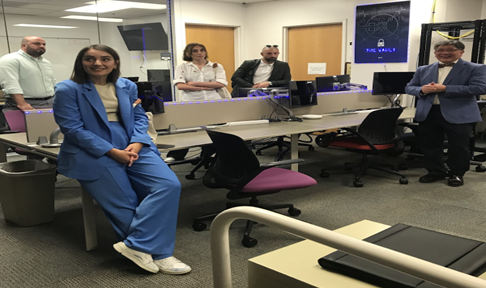Compiled by Layla Melendez, Communications Intern, Global Ties U.S.
This October, the Global Ties Network is taking a look at how international exchange programs like the International Visitor Leadership Program (IVLP) engage emerging leaders in the digital technology and cybersecurity fields. In the snapshots below, Utah Global Diplomacy reflects on what fried chicken taught IVLP participants about security vulnerabilities, Global Minnesota explores networking opportunities available to science and technology entrepreneurs, World Denver discusses media challenges related to disinformation and artificial intellegence, and the Georgia Council for International Visitors dives into opportunities available with 5G networks.
Utah Global Diplomacy
IVLP: Promoting Cybersecurity
NPA: Cultural Vistas
By Nick Merrill, Program Officer

Big smiles as IVLP participants meet Albert Tay, Ph.D., standing at the far right. Photo provided by Utah Global Diplomacy
For Albert Tay, Ph.D. at Brigham Young University, the warm smell of fried chicken drums and wings is irresistible. From the moment future Cybersecurity professionals first meet Albert in the classroom, he begins to tell them about his obsession with crispy fried chicken. In between discussions about the principles of least privilege, system vulnerabilities, and user authentication, he ranks his favorite places to pick up fried fare.
Most students dismiss Albert’s ramblings as an amusing diversion from the more serious business of protecting digital resources from internal and external threats. But one discerning student finally saw the real meaning behind his quirky professor’s cravings and brought piping hot drumsticks to class. He took a bite of chicken and publicly rewarded the student for his gift. When other students protested, it was time for an unforgettable lesson in cybersecurity.
With a twinkle in his eye, Albert reminded his students how they had discussed system vulnerabilities at length. “This,” he said, raising a piece of fried chicken above his head, “is my vulnerability.” He explained that often, digital weaknesses and insecurities are hidden in plain sight. And if students cannot detect them, malicious actors often will.
When Albert shared this story with our IVLP delegation of the top cybersecurity professionals in Georgia, they laughed and nodded knowingly. Though our physical world feels smaller and more interconnected than ever before, distance is truly zero in the digital domain. Successful attacks on vulnerable systems can impact millions of users worldwide.
Most of the discussion during this program was unintelligible to a non-expert because it took place in the shared language of those who are tasked with protecting our fragile digital world. A strong sense of camaraderie and international cooperation was the program’s throughline. Whether facing the threat of state-sponsored cyberattacks or the temptation to order some fried chicken, we are certainly stronger together.
Global Minnesota
IVLP: Science and Technology Entrepreneurship
NPA: Institute for International Education
By Nicholas Hayen, Marketing & Communications Manager
As a world leader in medical device development and high-tech research, Minnesota offers international visitors a unique opportunity to make critically-important connections in a rapidly developing field. Despite the increased tension over recent international events, we recently hosted a group of nearly a dozen science and technology entrepreneurs from across the Near East and North Africa, including two participants from Israel, who came together through Global Minnesota to share expertise on implementing advanced technologies in fields as diverse as education, agriculture, and healthcare.
The group landed on a Thursday afternoon to cold rain and rapidly falling leaves. The weather in Minnesota changes from hot summers to cold winters about as quickly as new technologies roll off the assembly line. After a night off to recharge at The Royal Sonesta hotel in downtown Minneapolis, the group met with Medical Alley, a leading nonprofit organization dedicated to spurring innovation in the healthcare field. Like the IVLP program itself, this organization works to build international connections with local Minnesota organizations to facilitate strong global relationships. Kylle Jordan, Global Principal for Medical Alley, noted that nearly all of their members want stronger ties outside the United States and greatly value these visits. After only a few short minutes, the visitors were already making plans to follow up with Medical Alley members on their own professional projects.

Introductory meeting at Medical Alley. All images provided by Global Minnesota.
The group then departed for a tour of the Bakken Museum, an interactive science and technology museum featuring “shocking” exhibits on the fun and functionality of electricity. The educational aspect of this visit resonated with Samia Aidoudi from Tunisia, who specializes in using virtual reality technology to transform the process of education. With the weekend fast approaching, the group took some much-needed time off to explore the city and volunteer with the nonprofit Feed My Starving Children.
Monday provided a packed day, beginning with a meeting with Medtronic, one of the state’s leading medical device manufacturers. This visit was especially helpful to Hiba Zarad, Product Manager at medical device company Boston Scientific. In particular, she was looking to know more about the innovations occurring in the “silicone valley” of medical device research. Lunch brought the group to the famous Holy Land Deli for a taste of familiar foods from around the Near East and North Africa.

The IVLP group poses for a picture with Medtronic employees.
The afternoon sessions were dedicated to tech innovations in the environment and agriculture. They stopped at the Minnesota Pollution Control Agency and the “Forever Green” campus of the University of Minnesota for a series of discussions on best practices for sustainability and controlling climate change. Bader Sater from Bahrain was especially excited to learn how businesses and government work together to build competitive ecosystems and spur success.

The IVLP group learns about best sustainability practices at University of Minnesota Campus.
In all, hosting this group was an incredibly valuable experience for the visitors, Global Minnesota, and the many science and tech companies that call this state home. Many of Global Minnesota’s closest corporate partners found significant value in the discussions and connections made over the course of just a few short days. Though global events sometimes push people apart, this visit helped spur inspiring innovations that discovered more ways science and technology can bring us all together.
WorldDenver
IVLP: Edward R. Murrow Program for Journalists – Media Responsibility in an Age of Disinformation
NPA: CRDF Global
By Shannon Payne, Senior Program Manager

Journalists gather for a presentation on media forensics. All photos provided by WorldDenver.
This October, WorldDenver had the pleasure of hosting the IVLP project, “Edward R. Murrow Program for Journalists – Media Responsibility in an Age of Disinformation.” During their Denver visit, 18 European journalists explored themes of youth media engagement, empowerment through journalism, and digital technology.
In a meeting with the National Center for Media Forensics (NCMF), the group dove into how media forensics works and discussed emerging media challenges such as deepfakes and artificial intelligence. NCMF Director Catalin Grigoras led the group in a thorough discussion of technology used to detect manipulation in photos and videos. In discussing deepfakes–synthetic media that have been digitally manipulated to replace one person’s likeness convincingly with that of another–Grigoras highlighted a well-known example replacing Amy Adams’ face with that of Nicolas Cage.

side-by-side look at image manipulation. On the left is an image of actress Amy Adams and on the right is a deepfake manipulation, in which her face was replaced with that of Nicolas Cage.
Unsurprisingly, the journalists had many questions. They went on to discuss newer media platforms like TikTok as well as the opportunities and threats presented by artificial intelligence. The meeting ended as some of the best IVLP meetings do: with visitors emailing the speaker on their way out the door proposing opportunities to collaborate further.
Attending this meeting, I was struck by how relevant the topic was to someone like me–not at all a journalist, but someone who often uses journalism and social media to understand what is happening around the world. It can be overwhelming, and honestly a bit scary to think about the sophisticated digital technology that could be used to manipulate people and undermine global security. However, projects like these–and leaders like our IVLP participants and the NCMF team, who are willing to share and work together to tackle these problems–always leave me feeling inspired.
Georgia Council for International Visitors
IVLP: Opportunities and Risks of 5G Networks
NPA: Mississippi Consortium for International Development.
By Lindsey Gantt, Program Coordinator
From October 3 – 7, the Georgia Council for International Visitors had the opportunity to host six telecommunication leaders from Costa Rica, the Czech Republic, Iraq, Mauritius, and Morocco to engage on the topic, “Opportunities and Risks of 5G Networks.” The Atlanta portion of the program focused primarily on exploring public/private 5G collaboration, 5G telecommunication infrastructure security, and city development opportunities with 5G technology. Throughout the week, the delegation met with The Advanced Technology Development Center at Georgia Tech, The Federal Communications Commission (FCC), and Curiosity Lab at Peachtree Corners – one of the first smart cities in the United States to be powered by city-owned connected infrastructure and 5G.

The delegation touring the Startup Hub at Curiosity Lab. All photos provided by GCIV.
We were excited by the prospect of being able to share a 5G powered city with our visitors. Our initial outreach to Curiosity Lab was for just a meeting and tour of their state-of-the-art facilities, but much to our surprise (and generosity of our resources!), they offered to invite our guests to a conference they were hosting on October 4: “The Last Mile: The Impact of Technology for Transportation.” This event offered our guests the opportunity to meet with founders, sponsors, and community members who are driving technology and 5G-powered solutions for the critical transportation segment in Georgia.
Throughout the day, the visitors were able discuss with panelists and telecommunication officials the challenges of pursuing public/private partnerships, which many of the visitors are navigating back home. The visitors were given an open space to ask their questions and were also able to share their experiences about how the telecommunication industry operates in their countries. Since no industry had the same regulations or partnerships, everyone was learning about new possible solutions and strategies to try for themselves. This event aligned with so many of their program goals, it felt like it was designed for our guests!
The next day, the group met with the Federal Communications Commission (FCC) over Zoom. Since the pandemic, most of our programming has been in person, but this was a great example of the accessibility of virtual meetings. The FCC was very interested in meeting with our delegation, but due to security protocol, we were unable to meet the deadlines for an in-person meeting. They offered to host a virtual meeting with members from several of their regional offices, and this offered a great opportunity for ample discussion in this meeting. The visitors were able to learn about 5G networks in urban and rural areas and how to ensure equitable access to services in both of these areas. The visitors were also able to share and learn about the different levels of regulation federal and local governments play in the implementation of telecommunication access in the United States.

Pooja Bhunjun, IVLP visitor from Mauritius, with a 5G-powered robot at Curiosity Lab.
A unique aspect of this program was each visitor’s willingness to share their challenges and successes with each other and our resources. It was amazing seeing how this technology can improve communication, transportation, and public safety, but everyone was willing to share the challenges of implementing and managing this kind of technology. There was a genuine pursuit of progress and innovation and an eagerness to build supportive partnerships with this group of visitors.
